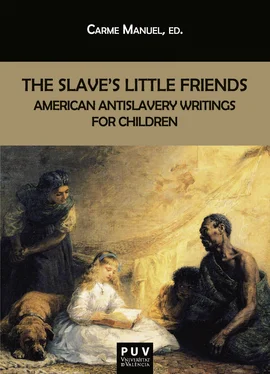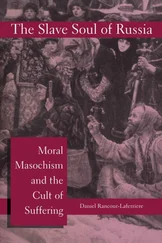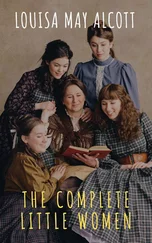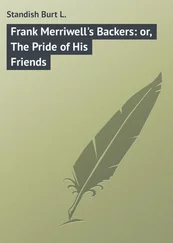For Donnarae MacCann, these fictional narratives do not mirror “the same potency” displayed by “the antiprejudice content” appearing in the Introduction (9). Yet, Cynthia M. Rogers’s research throws light on the decisions that American religious congregations took on the issue of slavery. She observes that the appearance of The Child’s Anti-Slavery Book, Containing a Few Words About American Slave Children and Stories of Slave-Life (1859) was saluted in the South although the book’s abolitionist content deserved rejection: “On April 21, 1859, John B. McFerrin, editor of the Publishing House of the Methodist Episcopal Church, South, in Nashville, declared in the Nashville Christian Advocate that certain works published for the Methodist Episcopal Church would “never see the light” in Southern church libraries. “Instance, The Child’s Anti-Slavery Book , from the press a few weeks since—a work we regard as far worse than Uncle Tom’s Cabin … Such publications are rank with abolition sentiments, and cannot be sold by our agency” (4).
STEP BY STEP, OR TIDY’S WAY TO FREEDOMwas published in 1862, the year in which Lincoln issued the Emancipation Proclamation. This is a juvenile religious novel by Mrs. Helen E. Brown, about a slave girl’s life on a plantation. We know the author was Brown, because the book appearing as “ Tidy’s Way to Freedom ” is listed under the name of “Mrs. H.E. Brown,” and its content summed up as “the story of a slave girl” in The Uniform Trade List Annual (1873, 20) and The American Catalog (1943, 700). In American Literary Gazette and Publishers’ Circular (Vol. 4, 1864, 11), she also appeared as the author of John Freeman and His Family (1864, 96 pages), another book belonging to a series entitled The Freedman’s Library, published by the American Tract Society in Boston. Mrs. Brown was a prolific writer of moral tales. In “Normalizing Subordination: White Fantasies of Black Identity in Textbooks Intended for Freed Slaves in the American South, 1863-1870,” Ronald E. Butchart (74-75) explains how northern writers catered for the need for specialized textbooks in freedmen’s schools. Among the readers he mentions Advice to Freedmen (1863) by Isaac W. Brinckerhoff, The Freedmen’s Book (1865) by Lydia Maria Child, Plain Counsels for Freedmen (1866) by Clinton B. Fisk, and Helen E. Brown’s (1864) John Freeman and His Family .
Step by Step, or Tidy’s Way to Freedom was published by the American Tract Society of Boston, and it contains eighteen chapters together with a short narrative titled “Old Dinah Johnson.” As explained by S.J. Wolfe, cataloger of the American Antiquarian Society, the American Tract Society (Boston, Mass.) originated in 1825 when the Boston-based American Tract Society merged with the New York Religious Tract Society, and maintained its autonomy. In 1859 “a major break occurred between the two American Tract Societies, due to a difference of opinion over the issue of whether or not to publish tracts which concerned ‘the sin of slavery.’ The American Tract Society continued to publish and distribute tracts under the name American Tract Society.”
The volume received attention and was soon included in all the important antislavery catalogs. The Boston Review. Devoted to Theology and Literature (Vol. III, 1863, 334) echoed its relevance when it included the title in the list appearing in 1862 with other books published by the American Tract Society of Boston: “Among the multitude of books upon the subject of Slavery which our recent troubles have drawn forth, these have won their way to the confidence of the public as authorities which will repay consultation, being careful in their inductions, philosophical in their methods, good in their temper, and hopeful in their auguries. Tidy’s Way to Freedom , together with titles such as Ministering Children by Maria Louisa Charlesworth, or Trust in God or Jenny’s Trials by Catherine Douglas Bell are a good addition to our Juvenile Christian literature. They are written in modern style, life-like, earnest, interesting and practical in their bearings toward a better life.”
“My story is not one of UNUSUAL interest,” writes the narrator in the Introduction, and continues to say that “[t]housands and ten of thousands equally affecting might be told, and many far more romantic and thrilling. What a day will that be, when the recorded history of every slave-life shall be read before an assembled universe! What a long catalogue of martyrs and heroes will then be revealed! What complicated tales of wrongs and woes! What crowns and palms of victory will then be awarded! What treasures of wrath heaped up against the day of wrath will then be poured in fiery indignation upon deserving heads! Truly, then, will come to pass the saying of the Lord Jesus, ‘The first shall be last and the last first.’” This prefatory chapter finishes with an invocation: “Then, too, will appear most gloriously the loving kindness and tender mercy of God, who loves to stoop to the poor and humble, and to care for those who are friendless and alone. It seems as if our Heavenly Father took special delight in revealing the truths of salvation to this untutored people, in a mysterious way leading them into gospel light and liberty; so that though men take pains to keep them in ignorance, multitudes of them give evidence of piety, and find consolation for their miseries in the sweet love of God. It is the dealings of God in guiding one of these to a knowledge of himself, that I wish to relate to you in the following chapters.”
The story of Tidy takes readers from the protagonist’s birth as a slave to the moment of her freedom and full embracement of the Christian faith in the chapter titled “Crowning Mercies.” The tale appeals to white child readers to make a comparison between their lives of comfort and ease with the cruelties suffered by Tidy in bondage. Hence, “[t]he reader is repeatedly invited to share in the national shame of having deprived Tidy of her childhood” (Hintz and Tribunella 66). The narrator closes the story with two instructive moral lessons. One is that “if God so loved a humble slave-child, and took such pains to bring her to himself, it is our privilege to feel the same sympathy and love for this poor despised race. And this love will draw us two ways: first, towards God, admiring and praising his infinite goodness and compassion; and, secondly, towards these prostrate, down-trodden people, to do all we can, in God’s name, and for his dear sake, for their elevation and instruction.” And the other is that “if God so loved this humble slave-child, he has the same love towards every one of you. Will you not yield yourselves to his control, and let his various loving-kindnesses draw you too to himself?” The tale broadens its message from a call for joining the antislavery ranks to an urgent appeal for religious conduct and an admonishment for proper social and moral life. White child readers are thus converted and shown the righteous path towards a Christian brotherhood.
THE GOSPEL OF SLAVERY: A PRIMER OF FREEDOM, a relevant antislavery primer by Iron Gray, was published in 1864, a year after Confederate troops were defeated at the Battle of Gettysburg. Iron Gray was the pseudonym used by Reverend Abel Charles Thomas (1807-1880), pastor of the Second Universalist Church and an active participant in the antislavery circles of Philadelphia.
He served a short pastorate in Lowell, Massachusetts, where in October 1840 he was one of the founders and editors of the Lowell Offering , a literary magazine written by “Factory girls” employed in the mills. Thomas helped and encouraged young women working in these textile mills who aspired to be writers. The Lowell Company produced cheap rough fabric, also known as “negro cloth” or “Lowell cloth,” that was sold to slave owners of the South. The members of the Second Universalist Church, organized around 1836, were mostly antislavery activists and in The Gospel Thomas condemns the industrial system of the North as the capitalist foundation stone of Southern slavery.
Читать дальше












